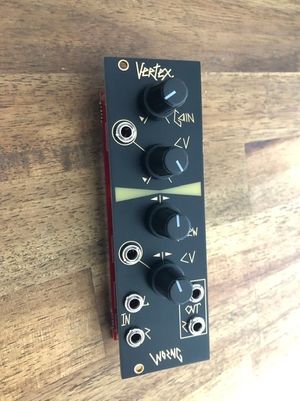RUN
The WORNG Vertex is a stereo VCA in 8HP that provides:
Stereo input and output.
Conversion of a mono input to stereo output.
Voltage control of a stereo signal.
Control of panning (for mono input) or skew (for stereo inputs) to the stereo output.
I first came across the Vertex when Morgan McWalters presented it during the mad week of online modular presentations that replaced Superbooth 2020. Morgan presented the Vertex Stereo VCA as well as the Parallax Stereo Low Pass Filter in a conversation with DivKid and Hainbach and the reaction in the chat room was overwhelmingly positive. Certainly, both modules were exciting to me but I took a little time to pull the trigger and buy the Vertex.
OBJECTIVE
So why did I feel the need to buy a stereo VCA? I was watching a Suzanne Ciani presentation at Synthbooth in October and noting how well she uses stereo panning for mono signals and thought to myself "I want to do that too!" So here we are, and the Vertex does not disappoint.

LOOK AND FEEL
The Vertex is a gorgeous module to look at and touch. It feels nice in hand and the knobs have just the right amount of resistance to let you tune your settings comfortably. The panning lights on the front (the back lit triangle shapes) leave you in no doubt as to where your signal should be sitting in the stereo panning range. The overall build feels solid and presentation is nice and clean. The module is 8HP with a depth of 25mm so should fit in most case solutions.

INS / OUTS
The front face presents the following ins and outs:
- 2 audio inputs (left and right)
- 2 audio outputs (left and right)
- CV input for your Envelope Generator
- CV input to control skew (for stereo inputs) and pan (for mono inputs)
KNOBS
The well spaced knobs provide functions as follows:
Gain - sets the base level for both VCAs when not engaged by your envelope generator. Fully CCW means no signal and fully CW means unity gain. For normal envelope generator operation you would leave it fully CCW, allowing the envelope to open and close the passing audio.
The Gain CV amount knob performs in an interesting way. At 12oc a 10V envelope will fully open the VCAs, and at fully clockwise 5V envelopes will fully open the VCAs. This is a nice arrangement and allows a comfortable level of control of envelope shaping within the Vertex.

SOUND AND RECORDING
The Vertex manual explains how clipping works with some neat diagrams. The manual is pretty easy to follow and nicely presented. All I will say is that the Vertex tone is nice and creamy and has the kind of personality that I enjoy in a VCA. Multi VCA modules like the Intellijel Quad VCA are great utilities but I really like specialised VCAs that create a sound character of their own, which is something I feel the Vertex does really well.
My initial objective was to take monophonic voices and just shift them around but of course if you have stereo effects, or VCFs, you are going to have a lot of fun skewing the stereo outputs of those modules, as well. I tested with Magneto, Z-DSP and Morphagene, as well as my Roland 521 dual VCF, and everything was perfectly splendid.
One thing that did not work the way my brain thought it would is pushing a square or stepped shape into the skew CV of the Vertex. The Vertex will respond to sudden changes, however as it is a very fast responding VCA, this can create additional 'artefacts' that sound like a clipping as it shifts the stereo field. The Vertex attenuates volumes on either side rather than swapping outputs between sides.
Recording stereo signal via the Vertex into my DAW was a very pleasing experience. Obviously the stereo field representation will depend upon your own audio engineering skills as well as the quality of your room and monitoring speakers. I use a pair of Focal Shape 65 monitors, which I enjoy mixing with very much, and have a decent (but not overcooked) stereo field in the room where I work.
I found that recording the Vertex into working projects created some nice variation of sound placement. You could argue it is easier and less expensive to do your panning in the box, but that means you are going to be limited in ways you can modulate panning from within your Eurorack patch. Also, it is just a lot of fun having this effect in the rack and being able to reach over and make fine adjustments as you track a part in real time.

CONCLUSION
All in all, the Vertex has been a very worthwhile purchase. I have found myself using it in most patches I have made since I installed it - from mono synth voices moving far left and right to very subtle displacement of hi-hat slurs. It does what it does very well and I even use it as a VCA with no stereo panning just because it is a really nice sounding VCA. My next purchase will be the Worng Parallax stereo VCF because that looks rad as hell, too.
PROS
Easy to use, easy to get results, fun.
Has a really nice tone to the VCA even when ignoring the stereo functionality.
Equally good at managing mono and stereo inputs.
CONS
- As a design choice, the VCA responds very quickly. Square or stepped envelope inputs can create an edge on the waveform which causes a sharp entry that sounds similar to clipping due to the harmonics.
